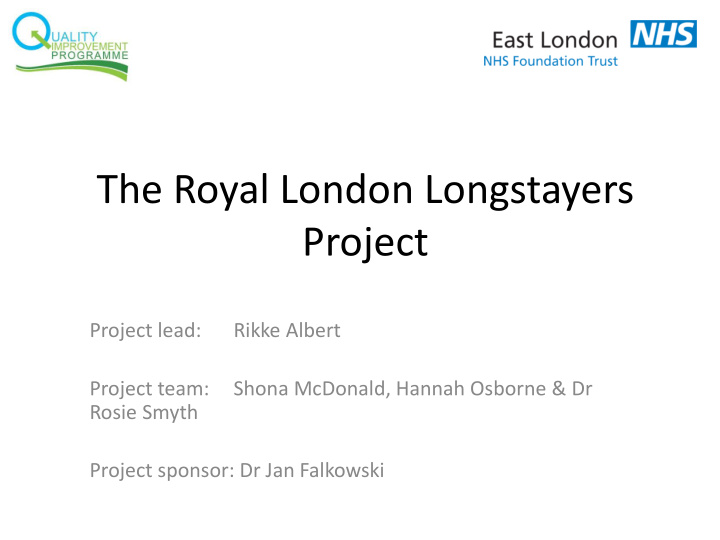



The Royal London Longstayers Project Project lead: Rikke Albert Project team: Shona McDonald, Hannah Osborne & Dr Rosie Smyth Project sponsor: Dr Jan Falkowski
Background • Why we chose the project – The long stay patients are at risk of co-morbid physical and mental health problems. The RLH has between 270-290 patients a week identified as long stay patients. • What was the problem? How to identify which 270-290 patients would benefit from a mental health assessment.
Background continued • The aim is to create an effective way of identifying long-stay patients who will benefit from input from the RAID team. • Development of a check list by 31 st of March 2015. • Increase the number of long stay patients taken on by the RAID June 2015 to 2 per week. • The long stay patients taken on by RAID to have a full psychosocial assessment with a completed care plan.
Driver diagram To increase the number of referrals to RAID of patients with unmet mental health needs who have a LoS of 30 days or more by 2 per week by July 2015 To develop a way of identifying the right patients Mental health Referrals Ward presence awareness Daily ward Whole ward MDT Managing complex Development of a attendance screening tool behaviour training training attendance
Sequence of PDSA’s – Cycle 4 : Barts health staff asked to use tool A P S D Cycle 3 : Focused on one ward and developed own screening tool Cycle 2 : Identified 2 pilot wards and used A P distress-ometer as a screening tool S D Cycle 1: : Attend the weekly long-stay meeting
Data Number of referrals referred to RAID team plotted monthly on a C chart 3 2.5 UCL LOS questionnaire Change the administration of the 2 tool, 2 pages changed 1 for staff, 1 for patient Distress thermometer 1.5 Number Referral 1 0.5 0 LCL 01 November 01 December 01 January 01 February 01 March 2015 01 April 2015 01 May 2015 2015 2015 2014 2014
Learning • Multiple PDSA is useful when trying to develop and test a different way of working in a complex system – there is less pressure to get it right. • Involving partners to get ‘buy in’ is important. We used the affinity diagram method as a framework for discussion on long stay patients and mental health.
What next? • The next step in the project is testing the screening tool further – use on elder care wards. • Barts health staff to test the tool. Challenges - • The rolling out the tool will require work on identifying barriers within Barts health and the mental health team.
Recommend
More recommend